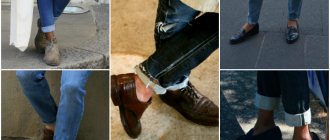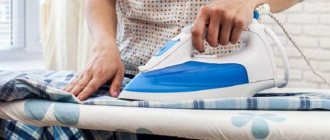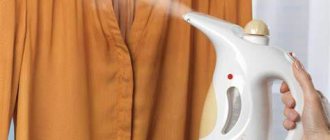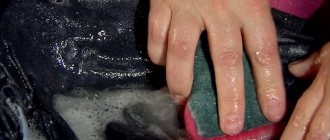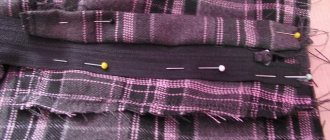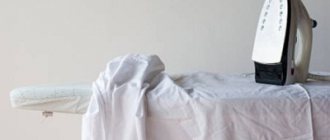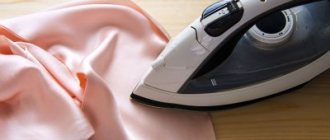Classic trousers are an essential element of a modern wardrobe. Despite the fact that most people prefer a loose casual and democratic style, there are etiquette, dress code and traditions in our lives, and in this case, formal trousers are irreplaceable.
Ironing trousers with creases is not difficult, but you will need patience and certain skills
Since the classic cut presupposes the presence of perfectly even arrows, each of us faces the difficult task of learning how to iron them. In this article, we have collected useful tips and tricks for you, thanks to which you can learn how to properly iron trousers with creases.
What to do before ironing
Check shortcut
Make sure your pants can be ironed.
Wash the pants
They must be clean, because under the influence of high temperature, any stain can become embedded in the fabric and it will be impossible to remove it.
Prepare a bottle of water with a spray bottle
To smooth out wrinkles, they need to be sprayed.
Take a clean towel
After ironing, a shine may appear on the trousers that should not be there. To avoid this, place a damp towel between the product and the iron. It will also help get rid of stubborn creases if you don't have a spray bottle.
Place an ironing board
It is best to iron trousers on her.
Useful tips
We have already learned how to make beautiful and straight arrows with our own hands. But here are some more necessary and useful tips to ensure that your things last for many years:
- If the tissue in the knee area is stretched , then we pay attention to it first. Using a damp cloth and tangential movements, we return it to its previous shape, and then iron it.
Strained knees can be corrected with a damp cloth and ironing
- For dry areas, use a vinegar solution. The instructions are as follows: soak a clean cloth in the solution and go over our trousers. This method is suitable for dark-colored trousers. For light colors, use a 2% hydrogen peroxide solution. Spray on dry areas and let dry, then rinse in water.
- For trousers made from natural fabrics : I advise you to sew up the creases with thread before washing. This way they won't separate from you. Afterwards we iron as usual.
Now you can make perfect arrows!
What temperature to choose
As a rule, any product has a label with care requirements. A special symbol will tell you how much you need to heat the iron so as not to spoil anything.
If there is no label, consider the type of fabric:
- Cotton - 180–220 °C;
- Linen - 215–240 °C;
- Viscose - 150–180 °C;
- Wool - 160–170 °C;
- Polyester - 140–155 °C;
- Silk - 140–165 °C;
- Mixed - choose the temperature according to the type of fabric for which it is lower.
How to iron
Place the ironing board comfortably. Fill the iron's water reservoir (you may need steam), select the desired temperature and leave the iron to heat up.
Start with the pockets
Pockets may be made of thin fabric, which requires a lower temperature. Turn them inside out and place them on the board so that the pant leg is not in your way.
Gently iron the trouser pockets until the wrinkles disappear. This will help avoid new wrinkles on the fabric in the future.
Go to the belt
Leaving the pockets inside out, pull the pant leg over the ironing board with the waistband facing you. Applying pressure with the iron, but without moving it back and forth, go over the waistband area from all sides, gradually rolling the pant leg on the board.
Hold the iron on the fabric for a few seconds, but be careful not to burn it. If unwanted wrinkles appear, straighten them and iron again.
Repeat with the second pant leg.
Further actions depend on whether your trousers have creases or without them.
Iron pant legs without creases
Straighten one pant leg along the seams and place it along the board, right side up. Smooth out any small wrinkles with your hands.
Start ironing from the top of the trousers. Apply pressure on the iron and move smoothly towards the bottom, moving from one seam to the next.
If the folds cannot be removed, turn on the steam function and bring the iron to the problem areas or use a spray bottle.
Iron the other side and repeat with the second leg.
Fabric processing conditions
Each material has its own characteristics not only in operation and washing, but also in ironing. The iron settings and the process itself depend on this.
We suggest you read: How to remove dampness in a private home
Cotton
The trousers must be dampened first. The temperature should be adjusted to approximately 150 degrees. The iron pressure should be strong. The steam is wet.
Cotton polyester
Lightly moisten the fabric and adjust the temperature to 110 degrees. Apply moderate pressure with the iron. Add a little steam.
Polyester
Do not wet the fabric, do not use steam. Heating is minimal, it is advisable to turn on the soft “silk” mode if available. The pressure is weak.
Viscose
Iron from the inside out through damp gauze with a little steam and medium pressure. Temperature - 120 degrees.
Pre-moisten and iron with plenty of steam, pressing firmly on the iron. Temperature at least 180 degrees.
Cotton linen
Pre-moisten and iron from inside out using strong steam. Press firmly. Temperature is about 180 degrees.
Iron dry fabric with medium pressure without steam at temperatures up to 80 degrees, it is advisable to use the special “silk” mode.
Iron dry trousers through damp gauze with gentle pressure without steam at a temperature of up to 80 degrees.
Nylon
It is better to avoid direct contact with the iron, as there is a high risk of melting the fabric. It is better to use vertical steaming with temperatures up to 80 degrees.
Jeans
Pre-moisten and iron through damp gauze from the inside out. Use strong pressure and steam. The temperature for soft fabric is 150 degrees, for rough fabric it is 180–200.
Knitwear
Using vertical steaming, iron from the inside out in the direction of the grain at minimum temperature.
Wool and wool mixture
Iron through damp gauze using horizontal steaming at a temperature of about 100 degrees.
Each item on its reverse side has a factory tag from the manufacturer indicating the exact composition of the fabric. You should carefully study what the material of the trousers is made of. After this, you need to select the ironing mode suitable for this type of fabric. This is a very important point, because the wrong temperature or ironing technique can not only ruin the crease, but also deteriorate the entire appearance of the trousers.
First of all, you need to adjust the temperature of the iron according to the type of fabric:
- flax – 180–200°C;
- cotton – 140–170°С;
- polycotton - about 110°C;
- wool and wool mixture – from 100 to 140°C;
- viscose – about 120°C.
Modern models of irons are equipped with a steam function, which significantly improves the quality of ironing and facilitates the process itself. However, in addition to steam, it is advisable to iron most fabrics through a damp cloth. This is especially true for materials with a fleecy or matte surface and various types of synthetics.
If your trousers are dry, you need to moisten them in advance by spraying them with water from a spray bottle or wrapping them in a damp cloth or towel. The second method gives the best result, because hydration occurs evenly, without traces of water drops. The wrapping method is especially good for light-colored trousers and materials with a shiny effect.
Another very important initial condition for our problem is the need to determine the optimal temperature regime.
If you can’t find the shortcut, then use our tips:
- Strong and durable cotton, which can be pre-moistened, can withstand high temperatures up to 170 degrees;
- A popular suiting fabric that holds folds well, is not afraid of steam treatment and the 200 degree mark;
- For woolen and wool blend products, vertical steaming and a temperature of no higher than 100–120 degrees are recommended;
- More capricious linen is turned inside out and smoothed at 200 degrees;
- Knitwear is ironed in medium heat mode on the reverse side and vertically treated with hot steam;
- Light silk is ironed in a delicate mode without steam and only from the inside with a dry iron through a dry lining. Satin and twill are ironed in the same way;
- Viscose should also be ironed carefully at 120 degrees with the possibility of steam treatment.
Depending on the type and structure of the original fabric, the regulator is set to the appropriate position, which will result in a perfectly ironed item without shine.
Principles and recommendations
The first thing to remember is don't rush. Only professionals can iron men's trousers quickly and correctly. Before ironing the creases on your trousers, you need to prepare to clean up the work surface and prepare the necessary tools:
- Iron with steam function to make the arrows perfectly straight and high-quality ironed.
- Ironing board. If it is not there, then you can use any table. The surface should be covered with a cloth made of dense material.
- Container with water. It will help wet your pants during the procedure.
- Sprayer for humidification.
- Gauze.
The soleplate of the iron must be free of dirt. Be sure to wipe it down or clean it before ironing.
An important condition is compliance with the specified temperature conditions.
To properly iron pants with arrows, it is recommended to adhere to the following rules:
- Ironing clean trousers. Under no circumstances should there be stains. Otherwise, due to high temperature, they will remain on the fabric forever.
- It is necessary to study the tag on the product. In addition to the composition, the temperature and mode for ironing are also indicated there.
- Before ironing your trousers, you should clean them of lint. To do this, use a special brush or roller with adhesive tape.
- There should be no items in your pockets.
Return to contents
If there is no gauze
Can you achieve perfect curls if you iron without gauze?
- How to shorten your own trousers by hand with and without cutting
- An iron with a steam generator will help you avoid damaging the fabric and make sharp arrows.
- Instead of gauze, you can use cotton fabric or a special mesh.
- Packaging, photocopier or printer paper can also replace gauze.
- In not-too-distant times, men put their pants under the mattress. In the morning they were excellent marksmen.
If a man takes on the task, it is recommended to watch the video to avoid troubles when ironing.
How to iron?
To make arrows on your trousers, you need to adhere to the following algorithm of actions:
- Smooth uneven and difficult areas of the product. This is the belt, codpiece and part near the pockets.
- Lay the pants out on an ironing board or table, turning the pants inside out.
- Iron the lining, if any.
- Iron the trouser legs. Carefully iron the joint seams. This must be done with each pant leg separately.
- Turning the product over to the front side, repeat the steps, first wetting the fabric with water using a spray bottle.
- Having laid out your trousers, you should straighten them with your hands. The internal seams must match. Place gauze on top and iron.
- Iron the seams. The fabric will dry out, so there must be constant moistening with water from a spray bottle or from a container prepared in advance. Before the procedure, you must compare the stitches. They should match, and the arrows should come out of the darts.
You can try on the product no earlier than 10 minutes after treatment.
Do not put on trousers after ironing. They must dry. You should leave the product for about 10 minutes. After they have become dry, you can put them on or hang them in a closet, preferably on a special hanger. If this is not done, the warm fabric will easily change shape, which means you will have to smooth out the arrows and carry out the procedure again.
How to maintain the effect?
There are secrets to preserving arrows for a long time:
- The arrows will remain on the product longer if you smooth them through a damp sheet of paper.
- Gauze with vinegar will seal the effect.
- Soap will also help. They are used to follow the arrows from the inside out, then the pants are steamed.
If you follow all the rules and listen to advice, then ironing creases on trousers will become an easy process that will not cause much trouble. In addition, it does not require special equipment or knowledge. Having brought the procedure to automaticity, less time and nerves will be spent on ironing. And the appearance will become an example for every person who wants to look beautiful, well-groomed and successful.
How to iron trousers with creases?
There is nothing more unsightly than the sight of wrinkled trousers with a hint of former creases. A self-respecting person would never appear in public wearing such clothes. Moreover, putting this important attribute in order is a simple procedure and takes only a few minutes. If only you know how to properly iron trousers with creases.
Tidying up trousers with creases is a simple procedure and takes just a few minutes.
Preparatory stage
Before you dive headfirst into work, make sure your pants are clean. Any stains, stains or dirt after ironing will be absorbed into the product, and it will be almost impossible to restore the previous appearance.
Carefully study the label on your trousers; this article will help you decipher the symbols on your clothes. Each fabric composition has its own temperature regime for ironing. Do not ignore the manufacturer's recommendation, and position the rotating circle on the iron at the desired points.
Prepare the ironing iron.
Pants with creases are always ironed through a piece of fabric (preferably white) or gauze. This will protect the product from shine, streaks or accidental damage.
The surface of the iron must be clean and free of carbon deposits. This, firstly, is the key to good gliding, and secondly, it will protect your things from contamination.
Ironing a dampened fabric is much easier and easier. Modern irons are usually equipped with a steaming mechanism. Fill the reservoir with water and activate the function on the iron. If this is not possible, use a spray bottle of water before ironing.
Men's and women's trousers
For women, trousers are available in various models: tapered, straight, cropped. They have a lot of darts, thanks to which the clothes gracefully fit the figure. Due to the significant difference in styles, ironing women's products is easier.
How to iron trousers for ladies? You need to lay them so that not only the fold lines are connected, but also the darts. You can use pins to secure things. After one trouser leg has been ironed, it is turned away and heat treatment of the second trouser leg begins.
The principle of ironing men's trousers is the same as women's trousers. The only difference is that such models have practically no darts. When ironing men's trousers with creases, you have to constantly monitor the location of the seams so that they do not move. First you should iron the most difficult parts: belt, pockets, codpiece with zipper, and only then proceed to the creases.
What you need to prepare
The most necessary thing is an ironing board. It should be stable and well lit. But in the absence of it, you can use any flat surface: table, sofa, bed, even the floor. You just need to first cover such a workplace with a thick blanket folded several times or a thin blanket, for example a flannelette.
You should first check the condition of the iron - its sole must be absolutely clean.
It is most convenient to use a device with a steaming function, then ironing with its help takes significantly less time. If there is no such function, the trouser fabric will have to be moistened periodically. For this you will need a spray bottle.
Do not allow an iron without a steam function to come into contact with the fabric. Therefore, it is necessary to prepare protective material.
How to iron trousers with creases without damaging the fabric? Do not allow the iron to come into direct contact with it without the steam generation function. Therefore, it is necessary to prepare protective material. Most often, this is a piece of pharmaceutical gauze or a piece of thin cotton fabric, which is moistened from time to time. You should not use newspaper for this purpose, as printing ink often prints on trousers.
Preparing a wardrobe item for ironing
Like any item that is going to be ironed, trousers must be clean before ironing. Most stains can be removed by regular washing; in the presence of pronounced stains, it is recommended to pre-treat the contaminated areas with a stain remover or simply a more concentrated solution of washing powder.
To wash items made of black, dark blue and other fabrics of dark shades, it is recommended to use liquid gels, since particles of washing powder can leave a light coating after drying, which is clearly visible against a dark background. The use of conditioners and rinses, which contain antistatic agents and substances that make ironing easier, is also encouraged.
Before you start ironing, you should take care of a comfortable place. The best option is an ironing board with an adjustable height, but don't despair if you don't have one. You can iron your trousers on any flat, horizontal surface, covered with a large soft terry towel and a piece of light cotton fabric. Synthetics and bright colors should be avoided, as they can leave hard-to-remove marks on the fabric of the trousers when in contact with a hot iron.
It is imperative to check the soleplate of the iron for dirt, which during ironing can “migrate” to clean trousers and hopelessly ruin your favorite item. Stains from the iron can be easily removed with a special cleaning pencil, and if there is none, then a cloth soaked in table vinegar can completely replace it. Only after preparing all the accessories and cleaning the iron to a shine, you can start ironing.
You should start by inspecting your clothes for stains and dirt, because the high temperature of the iron will make them more noticeable. Villi and hair can be removed with a dampened brush or a special roller. It is necessary to check the pockets for the presence of foreign objects, and the surface of the iron, which must be clean.
You can iron your trousers correctly using step-by-step instructions:
We suggest you read Caring for your computer, TV and phone screen - how to clean monitors
- Turn the product inside out. The lining will need to be processed. A rather thin fabric is always used for it. Set the iron to the minimum temperature to prevent it from melting. Actions can be carried out without gauze.
- It is necessary to iron the pockets, under which to place cardboard or a towel to avoid imprints on the pant leg. Then work on the belt and codpiece. Turn the product right side out to perform the main work.
- Lay the clothes out on a flat surface, smooth them with your hands, straightening the seams, and go over them with an iron, trying not to touch the creases if they already exist. It is necessary to use moistened gauze and cloth. It is important to try to straighten the lining to avoid wrinkles. A towel or cardboard next to the pockets will come in handy.
- Determine the location of the arrows. To keep them in place, secure them at the bottom with office clips and along the fold with pins. Lay out the trousers evenly, lift up the upper trouser leg, and begin ironing from the knee area, simply leaning the iron against it. Then stretch the material a little and secure the result.
- Straight trousers with creases are easier to iron than those with a tapered hem, where you will have to place a small piece of fabric to steam the seams.
- Having finished with one pant leg, proceed to the other. Rotate the product and repeat the process.
Ironing rules may seem complicated, just like the work itself. The first time will take a lot of time. Gradually, the movements will become honed, and you won’t have to wait long for results.
Temperature
It is extremely important to determine the optimal iron temperature. Graphic information about the maximum permissible heating is located on the product label. But if it is not preserved, you need to remember:
- silk, satin, twill should be ironed at a gentle temperature of up to +100°C with an iron without steam, and through dry gauze;
- viscose and knitwear can withstand heating up to +120°C and steaming;
- Woolen trousers with creases can be ironed at a temperature not exceeding +120...+130°C;
- for thick cotton fabric that can be moistened, the temperature can be set to +170°C;
- suiting fabrics, on which folds often last a long time, are not afraid of +200°C.
It is extremely important to determine the optimal iron temperature to successfully iron a particular fabric.
Algorithm of actions
It is important to know how to iron trousers with creases correctly. The main principle: first, almost all the details of the item are ironed from the inside out. It is turned right side out when the arrows begin to be ironed.
These steps can be performed in different ways. For example, immediately iron both pant legs laid on top of each other, ironing them on one side and then on the other side. But you can process each trouser leg separately.
- The trousers turned inside out should be put on the narrow part of the board and the waistband and lining should be steamed.
- Then move on to the pockets. To prevent traces from appearing on the front side, place a towel, a piece of cardboard or a sheet of thick paper.
- Then finish the side seams. We must not forget about periodically moistening the gauze, even if the iron has a steam function.
- Then fold the product so that the legs are exactly aligned on the sides and bottom edge, and iron them, not reaching the arrows. You can secure the trouser legs with pins, bobby pins, needles or metal stationery pins. But if you have to iron on an uneven surface, the fabric can still warp.
- Finally, the most important thing: how to make creases on trousers with an iron. It is necessary to fold the product so that the fold lines are exactly aligned with the darts coming from the waistband. The darts in the front are the beginning of the arrows, this is approximately 7 cm from the waistband.
- When ironing the fabric, the trouser legs will not move if you do not slide the iron over them, but gradually move it forward along the entire fold line, then back.
The main principle of ironing trousers with arrows: first, almost all the details of the item are ironed from the inside out.
Secrets of the right arrows
To better consolidate the result, we recommend watching training videos. It clearly shows how to properly iron trousers and how to create creases in different ways. Remember a few important secrets that will make the process easier and faster:
- To secure the arrows and keep them clear until the next wash, before ironing, walk along the fold line from the inside with dry laundry soap;
- You can replace soap with a solution of water, 9% vinegar and starch. For a liter of liquid, take a tablespoon of vinegar and a teaspoon of starch. Mix everything thoroughly and apply from the inside out to the place of the future fold. Then turn the trouser leg inside out and iron it.
- Always iron the front side of suit pants using cheesecloth or an iron attachment;
- A warm terry towel will help you iron your trousers with tape. Synthetic tape is usually sewn onto the bottom of the pant leg to add weight and give it a more elegant look. However, during the ironing process, due to the high temperature, it often bunches up, causing the fabric to wrinkle. To smooth the material, cover the ironed area with a towel and leave to cool for 20-30 minutes. Gradually the tape will return to its original position.
- Remember - it is correct to iron only clean trousers. Any contaminants under the influence of steam will go even deeper into the fabric, and washing them off will be very problematic;
- Immediately after ironing, allow the pants to cool before they can be put on.
"Long-lasting" arrows
1st option. The classic way to fix the arrows for a long time is to go over them from the inside with a slightly damp piece of laundry soap, and then iron the folds from the front side.
2nd option. Table vinegar helps to secure the folds. 1 tbsp. l. Dilute the 9% solution in 1 liter of water, moisten the gauze and iron the trouser legs through it.
3rd option. Prepare paste for trousers with arrows: 3 tsp. Dilute starch in a small amount of cold water and pour into 200 ml of boiling water while stirring. Then after 2-3 minutes remove from heat and cool. Lubricate the fold lines from the inside with a thin layer of the resulting paste. Wait until it is completely dry and iron the arrows from the front side.
Correcting ironing errors: marks, marks, double arrows
Unfortunately, we often forget to use the iron and unsightly shiny spots remain on the fabric. Fortunately, in most cases these problems can be fixed.
How to remove shine and shine
Laces are the shiny marks left by the soleplate of an iron. They are most noticeable on dark fabrics made from natural, mixed and synthetic fibers. The problem can be resolved in the following ways:
- If the fabric is made of cotton or linen, then lasses are almost always removed by steaming through a damp iron.
- If the fabric is mixed, you will need to prepare a solution of water, vinegar and a few drops of liquid soap. Moisten gauze in the solution and iron the problem area through it until the stain completely disappears.
- Ammonia will help remove shine from woolen fabrics. A few drops of ammonia are diluted in a liter of water. Then proceed in the same way as in the first method.
- Lass on synthetic fabrics is removed with gasoline. A cotton pad is soaked in the product, and then the stain is treated with it. After this treatment, the product is washed and dried naturally.
- Shine from dark suit fabrics is also removed with unsweetened black tea: moisten a cotton swab and treat the stain.
- You can also re-wash your pants and add fabric softener when rinsing.
If you are unable to remove the lasses yourself, you should take your trousers to the dry cleaner. In the case of synthetic fabrics, it also happens that the shine from the iron remains. In this case, the trousers are ruined forever.
Video: how to remove shine from an iron from trousers
How to remove scorch marks from an iron
Tan marks are yellow spots that are most noticeable on white, light-colored and colored fabrics. They are more difficult to eliminate than lasses. For these purposes, the following methods are used:
- Lemon and powdered sugar. Rub the stain with a slice of lemon and sprinkle with powdered sugar. Allow it to dry, and then partially wash the treated area or wash the product completely.
- Onion gruel. Apply onion pulp to the scorched area and leave until completely dry. Then wash and dry as usual. You can also use onion halves and rub them thoroughly onto the stains.
- Vinegar and salt. Make a solution of 9% vinegar and water in equal proportions. The scorched area is soaked in the solution and then sprinkled with salt. After the fabric has dried, the product is washed.
- 3% hydrogen peroxide. Use only on white fabrics. Peroxide is applied to a cotton swab and the area with the tan is treated. After the treated area has dried, rinse it in cold water.
If you are unsure of your abilities and are afraid of completely ruining your trousers, then immediately contact the dry cleaner.
How to eliminate double arrows
It is not always possible to make correct single arrows the first time. If during ironing the trousers slid along the ironing surface, then it is likely that double creases will form, which will obviously not please the person who is going to wear these trousers. Fortunately, it is much easier to remove “homemade” arrows than stable industrial ones formed under a special press. Do the following:
- Turn your pants inside out.
- Lay out so that the arrows are in the middle of the trouser leg.
- Moisten the gauze thoroughly and place it on the problem area.
- Iron until the arrows disappear.
The disadvantage of this method is that, most likely, you will get rid of the “factory” arrow and will have to form it again. We advise you to first try to fold the trousers correctly so that the seams match, and then iron them well with steam. Perhaps the extra arrow will disappear. You can also wash your trousers and then try to iron them better.
You can try to eliminate the extra arrow by ironing it through a wet cloth.


